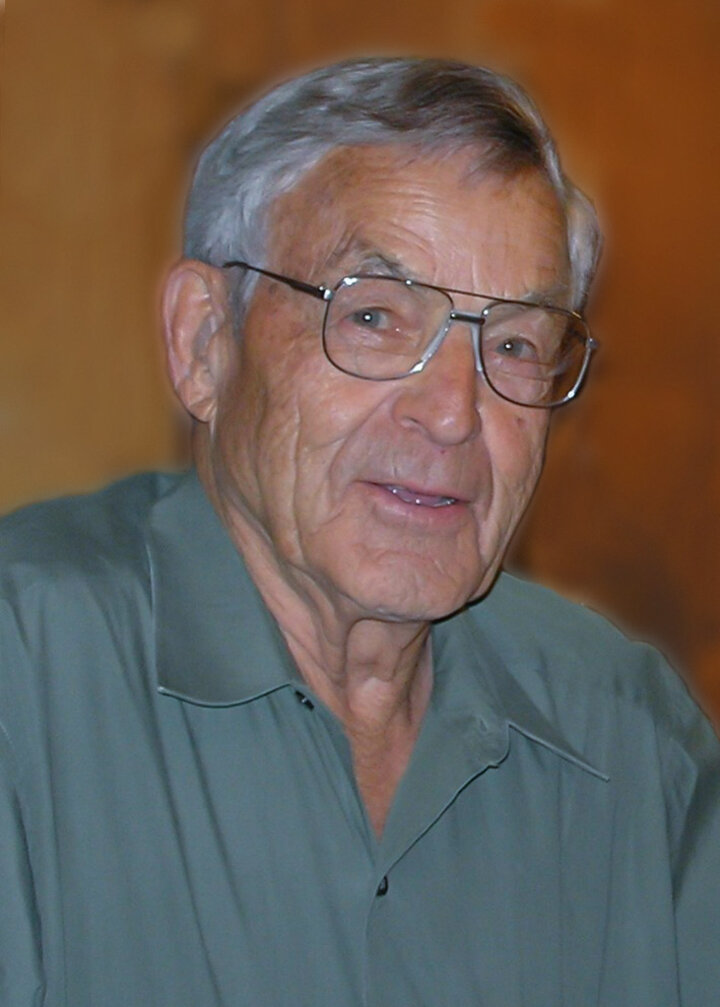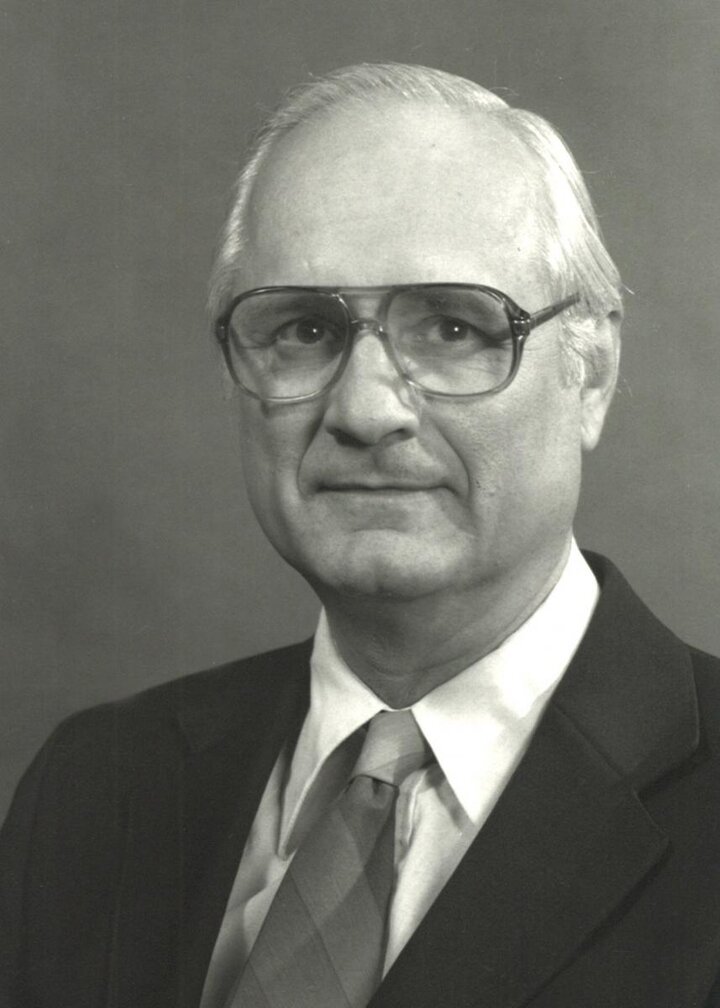Arden Albert Baltensperger and Robert "Bob" Sorensen, University of Nebraska–Lincoln alumni, received the Department of Agronomy and Horticulture 2021 Alumni Lifetime Achievement Award
This award is the highest honor bestowed upon graduates of the Department of Agronomy and Horticulture who have made significant contributions to their community, state and nation through professional service, public service and/or civic engagement. The award was founded in 2016 to recognize alumni who have enhanced the reputation of the department and the university by distinguishing themselves in their careers. Honorees are selected by the Agronomy and Horticulture Alumni Advisory Council (AHAAC).

Arden Albert Baltensperger
December 25, 1922 – October 6, 2015
Growing up on a farm near Kimball, Nebraska, during the Dust Bowl and the Great Depression, Arden Albert Baltensperger credited the many lessons from that childhood with spurring an interest in plant science.
He attended District 22, a one room grade school, and graduated from Kimball County High School in 1940. Baltensperger’s older brother, Dwight, encouraged him to go to the University of Nebraska–Lincoln and provided just enough money for the bus ticket to Sidney, Nebraska. From there Arden hitchhiked to Lincoln and spent the next three years at the university. World War II interrupted his education in 1943.
Baltensperger served in the U.S. Army as an officer in the Field Artillery in the Pacific Theater for the next three years. He returned to the Nebraska in 1946 and received a Bachelor of Science degree in technical science in 1947. In 1949, he received a Master of Science degree in plant breeding, also from Nebraska. From 1949 to 1954, Baltensperger operated a stock farm for his father-in-law near Denton, Texas, and conducted soil fertility research at the Texas A&M Denton Branch Station. He earned a Ph.D. from Iowa State University in 1958. Part of his doctoral research resulted in the isolation of seed shattering resistance which was subsequently used in cultivar development. Baltensperger joined the faculty at the University of Arizona in 1958 where he conducted research on grain sorghum and turfgrass. He helped determine control for the bermudagrass eriophyid mite and helped develop standards which led to the first certification of seeded bermudagrass. He was also active in teaching both undergraduate and graduate instruction and initiated a plant breeding course. In 1963, he accepted the position as chairman of the Agronomy Department at New Mexico State University, which he held for 12 years. In 1975 he returned to a professor of agronomy position until his retirement from NMSU in 1988.
During this time a Ph.D. program was initiated, and student enrollment increased substantially. In addition, physical improvements, mainly the Leyendecker Plant Science Research Center, were planned and completed, and the Soil and Water Testing Laboratory was reorganized to better serve the farm, ranch and research needs of the state. As chair of the Western Soil and Water Research Committee, he initiated a review and appraisal of all soil and water research in the western states and helped start a research program in turfgrass irrigation conservation at NMSU.
He was especially proud of the development of the graduate student program in the department and trained several graduate students including Roch Gaussoin, agronomy professor at Nebraska.
Baltensperger's academic achievements have been recognized worldwide through his breeding of turf-type and forage bermudagrasses. His efforts led to the release of NuMex Sahara, the first improved seed-propagated turf-type bermudagrass along with six additional seeded varieties, including Princess 77. Princess 77 was used as the foundation of the playing surface used in the NFL's Super Bowl in 2004 and 2005.
His bermudagrasses are grown for recreation and livestock feed in Egypt, Asia, Australia, Hawaii and in 21 states of the continental United States. At many of the overseas locations, soil conditions, water quality and water availability would have prevented the use of grasses if his seeded bermudagrasses had not been available. Baltensperger's last article on seeded bermugrass 'A century of seeded bermudagrass production – and more to come' was published in November 2014 when he was 91 years old.
Baltensperger was active in the American Society of Agronomy, the Crop Science Society of America, the Southwest Turfgrass Association and the honorary agriculture fraternity, Gamma Sigma Delta.
He served as president of the ASA, the Western Society of Crop Science and of the first chapter of Gamma Sigma Delta at NMSU. He served as international president of Gamma Sigma Delta. He was a member of the ASA & CSSA Board of Directors.
Baltensperger received recognitions for his work including the ASA Fellow, CSSA Fellow and the Fred Grau Turfgrass Science Award in recognition of significant career contributions to turgrass science.
After retiring from NMSU, Baltensperger served as research director and later as consultant for the Pennington/Seeds West Co. in Yuma, Arizona from 1988 to 2010.
Baltensperger was also involved in community organizations included Kiwanis, Voz Vaqueros – the Singing Men of Las Cruces – and the Presbyterian Church.
Much of Baltensperger’s life was devoted to teaching and plant breeding and he leaves a professional legacy of successful students and plant improvement.

Robert "Bob" Sorensen
July 24, 1933 – June 4, 2019
Robert "Bob" Sorensen’s professional life as a professor of agronomy at the University of Nebraska–Lincoln revolved around teaching for student learning and student welfare.
Born and raised on farms near Gretna and Papillion, Sorensen earned a Bachelor of Science degree in technical science in agriculture from Nebraska in 1955. While an undergraduate, he enrolled in the ROTC program as required for young men at the time. He then completed an advanced course which earned him commission as a Second Lieutenant in the U.S. Army Reserve upon graduation.
Sorensen went on to earn a Master of Science in agronomy in 1957 from Nebraska before serving six months of active duty. He also spent eight years in the U.S. Army Reserve.
In 1964, Sorensen earned a doctorate in soil chemistry from Iowa State University.
Sorensen was hired at Nebraska as an assistant professor of agronomy with a 75% teaching and 25% research assignment in 1964. He went on to focus solely on teaching and achieved ranks of associate professor and professor of agronomy in 1971 and 1975, respectively.
Students were always the center of his work. He taught over 6,000 students over 35 years at Nebraska. He was consistently among the highest-ranked teaching faculty in student evaluations.
According to colleagues, Sorensen was a creative instructor who cared about his students and wanted to educate the whole person, not just impart knowledge. He believed each student was an individual and based his teaching on meeting individual needs rather than on meeting generalized class needs. Students appreciated his dedication to their well-being, along with his concern regarding learning. His sincere interest in students, combined with his subtle sense of humor, led to student enjoyment of the learning process.
Sorensen taught many classes including Agronomy 153 Introduction to Soil Science. In 1988 he developed a new design for the course where students learned in cooperative small groups. He also developed and implemented computer programs for teaching as the technology developed.
He was a dedicated supporter of the University Foundations Program for freshmen and served on the University Teaching Council and as the Department of Agronomy teaching coordinator. In 1978 he served as Acting Assistant Dean to the College of Agriculture for two months.
In addition to teaching students, Sorensen also served as expert and teacher for the Myers-Briggs Type Indicator® personality inventory to Institute of Natural Resources and Nebraska Extension staff across Nebraska.
Sorensen was very active with the Nebraska Future Farmers of America Association and directed the FFA Agronomy contests from 1971 until his retirement in 1999. He was awarded the Honorary State FFA Degree from Nebraska FFA Association in 1993 and the Nebraska Department of Education FFA Distinguished Service Award in 1996.
In addition to his many teaching duties, Sorensen published 31 research articles, wrote 11 educational publications, and wrote two books.
Sorensen received many awards during his career from the university and North American Colleges and Teachers of Agriculture in recognition of his outstanding teaching.
University honors included the Amoco Distinguished Teaching Award, College of Agricultural Sciences and Natural Resources Innovation in Teaching Award, CASNR Distinguished Teaching Award, Recognition Award for Service to Students, and the Teaching Award of Merit from Gamma Sigma Delta, the Honor Society of Agriculture–Nebraska Chapter. He was awarded the UNL Recognition Award for Service to Students six times and appointed to the Academy of Distinguished Teachers.
Sorensen received the NACTA Distinguished Service Award, NACTA Distinguished Educator Award, NACTA Teaching Award of Merit and the E.B. Knight NACTA Journal Award, in 1987 and 1993. In 1975 he was awarded the NACTA Teacher Fellow and Outstanding Teacher Fellow, Central Region.
In 1994 Sorensen was awarded the Soil Science Society of America Soil Science Education Award. Papillion High School awarded him the Distinguished Alumni Award in 1996.
He was a member of Sigma Xi, Alpha Zeta, Gamma Sigma Delta, NACTA and the university’s Academy of Distinguished Teachers.